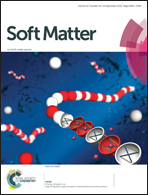Salt-dependent properties of a coacervate-like, self-assembled DNA liquid†
Abstract
Liquid–liquid phase separation of a polymer-rich phase from a polymer-dilute solution, known generally as coacervation, has been observed in a variety of biomolecular systems. Understanding of this process, and the properties of the resulting liquid, has been hampered in typical systems by the complexity of the components and of the intermolecular interactions. Here, we examine a single-component system comprised entirely of DNA, in which tetravalent DNA nanostar particles condense into liquids through attractive bonds formed from basepairing interactions. We measure the density, viscosity, particle self-diffusion, and surface tension of NS-liquid droplets. The sequence- and salt-dependent thermodynamics of basepairing accounts for most properties, particularly indicating that particle transport is an activated process whose barrier is the breaking of a single bond, and that very few bonds are broken at the surface. However, more complex effects are also seen. The relation of density to salt shows that electrostatic screening compacts the NS particles. Further, the interrelation of the transport properties indicates a breakdown of the Stokes–Einstein relation. This observation, in concert with the low surface tension and single-bond transport barrier, suggests this DNA liquid has a heterogeneous, clustered structure that is likely enabled by internal NS particle flexibility. We discuss these results in comparison to other coacervate systems.



 Please wait while we load your content...
Please wait while we load your content...
